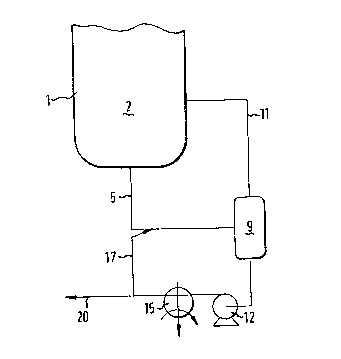Une partie des informations de ce site Web a été fournie par des sources externes. Le gouvernement du Canada n'assume aucune responsabilité concernant la précision, l'actualité ou la fiabilité des informations fournies par les sources externes. Les utilisateurs qui désirent employer cette information devraient consulter directement la source des informations. Le contenu fourni par les sources externes n'est pas assujetti aux exigences sur les langues officielles, la protection des renseignements personnels et l'accessibilité.
L'apparition de différences dans le texte et l'image des Revendications et de l'Abrégé dépend du moment auquel le document est publié. Les textes des Revendications et de l'Abrégé sont affichés :
| (12) Brevet: | (11) CA 2009565 |
|---|---|
| (54) Titre français: | PROCEDE DE DISTILLATION SOUS VIDE |
| (54) Titre anglais: | VACUUM DISTILLATION PROCESS |
| Statut: | Périmé et au-delà du délai pour l’annulation |
| (51) Classification internationale des brevets (CIB): |
|
|---|---|
| (72) Inventeurs : |
|
| (73) Titulaires : |
|
| (71) Demandeurs : |
|
| (74) Agent: | SMART & BIGGAR LP |
| (74) Co-agent: | |
| (45) Délivré: | 2000-05-30 |
| (22) Date de dépôt: | 1990-02-08 |
| (41) Mise à la disponibilité du public: | 1990-08-10 |
| Requête d'examen: | 1997-01-13 |
| Licence disponible: | S.O. |
| Cédé au domaine public: | S.O. |
| (25) Langue des documents déposés: | Anglais |
| Traité de coopération en matière de brevets (PCT): | Non |
|---|
| (30) Données de priorité de la demande: | ||||||
|---|---|---|---|---|---|---|
|
Vacuum distillation process comprising introducing
a feed which contains vapour and liquid into a
distillation column (1) operating at a subatmospheric
pressure, allowing vapour to rise inside the
distillation column (1), allowing liquid to drop to the
bottom part (2) of the distillation column (1) and
passing liquid from the bottom part (2) of the
distillation column (1) through a transfer conduit (5)
to an external collecting vessel (9) from which a
liquid stream is withdrawn, cooling of the liquid
stream and introducing part of the cooled liquid stream
through conduit (17) into the liquid passing through
the transfer conduit (5).
Note : Les revendications sont présentées dans la langue officielle dans laquelle elles ont été soumises.
Note : Les descriptions sont présentées dans la langue officielle dans laquelle elles ont été soumises.

2024-08-01 : Dans le cadre de la transition vers les Brevets de nouvelle génération (BNG), la base de données sur les brevets canadiens (BDBC) contient désormais un Historique d'événement plus détaillé, qui reproduit le Journal des événements de notre nouvelle solution interne.
Veuillez noter que les événements débutant par « Inactive : » se réfèrent à des événements qui ne sont plus utilisés dans notre nouvelle solution interne.
Pour une meilleure compréhension de l'état de la demande ou brevet qui figure sur cette page, la rubrique Mise en garde , et les descriptions de Brevet , Historique d'événement , Taxes périodiques et Historique des paiements devraient être consultées.
| Description | Date |
|---|---|
| Inactive : Renversement de l'état périmé | 2012-12-02 |
| Le délai pour l'annulation est expiré | 2010-02-08 |
| Lettre envoyée | 2009-02-09 |
| Inactive : CIB de MCD | 2006-03-11 |
| Accordé par délivrance | 2000-05-30 |
| Inactive : Page couverture publiée | 2000-05-29 |
| Inactive : Taxe finale reçue | 2000-02-28 |
| Préoctroi | 2000-02-28 |
| Un avis d'acceptation est envoyé | 1999-09-27 |
| Un avis d'acceptation est envoyé | 1999-09-27 |
| Lettre envoyée | 1999-09-27 |
| Inactive : Approuvée aux fins d'acceptation (AFA) | 1999-09-02 |
| Modification reçue - modification volontaire | 1999-08-19 |
| Inactive : Dem. de l'examinateur par.30(2) Règles | 1999-03-04 |
| Inactive : Dem. traitée sur TS dès date d'ent. journal | 1998-04-06 |
| Inactive : Renseign. sur l'état - Complets dès date d'ent. journ. | 1998-04-06 |
| Toutes les exigences pour l'examen - jugée conforme | 1997-01-13 |
| Exigences pour une requête d'examen - jugée conforme | 1997-01-13 |
| Demande publiée (accessible au public) | 1990-08-10 |
Il n'y a pas d'historique d'abandonnement
Le dernier paiement a été reçu le
Avis : Si le paiement en totalité n'a pas été reçu au plus tard à la date indiquée, une taxe supplémentaire peut être imposée, soit une des taxes suivantes :
Veuillez vous référer à la page web des taxes sur les brevets de l'OPIC pour voir tous les montants actuels des taxes.
| Type de taxes | Anniversaire | Échéance | Date payée |
|---|---|---|---|
| Requête d'examen - générale | 1997-01-13 | ||
| TM (demande, 8e anniv.) - générale | 08 | 1998-02-09 | 1998-01-06 |
| TM (demande, 9e anniv.) - générale | 09 | 1999-02-08 | 1998-12-29 |
| TM (demande, 10e anniv.) - générale | 10 | 2000-02-08 | 1999-11-30 |
| Taxe finale - générale | 2000-02-28 | ||
| TM (brevet, 11e anniv.) - générale | 2001-02-08 | 2001-01-09 | |
| TM (brevet, 12e anniv.) - générale | 2002-02-08 | 2001-12-11 | |
| TM (brevet, 13e anniv.) - générale | 2003-02-10 | 2002-12-23 | |
| TM (brevet, 14e anniv.) - générale | 2004-02-09 | 2004-01-15 | |
| TM (brevet, 15e anniv.) - générale | 2005-02-08 | 2005-01-18 | |
| TM (brevet, 16e anniv.) - générale | 2006-02-08 | 2006-01-16 | |
| TM (brevet, 17e anniv.) - générale | 2007-02-08 | 2007-01-16 | |
| TM (brevet, 18e anniv.) - générale | 2008-02-08 | 2008-01-16 | |
| TM (demande, 2e anniv.) - générale | 02 | 1992-02-10 |
Les titulaires actuels et antérieures au dossier sont affichés en ordre alphabétique.
| Titulaires actuels au dossier |
|---|
| SHELL CANADA LIMITED |
| Titulaires antérieures au dossier |
|---|
| JOHANNES A. HAMER |
| PIETER VAN DER HEIJDEN |